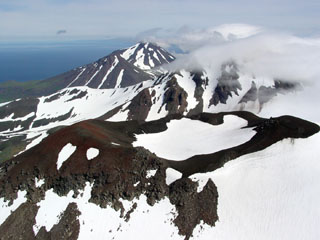Report on Atka Volcanic Complex (United States) — May 1986
Scientific Event Alert Network Bulletin, vol. 11, no. 5 (May 1986)
Managing Editor: Lindsay McClelland.
Atka Volcanic Complex (United States) Steam emission follows magnitude 7.7 earthquake
Please cite this report as:
Global Volcanism Program, 1986. Report on Atka Volcanic Complex (United States) (McClelland, L., ed.). Scientific Event Alert Network Bulletin, 11:5. Smithsonian Institution. https://doi.org/10.5479/si.GVP.SEAN198605-311160
Atka Volcanic Complex
United States
52.331°N, 174.139°W; summit elev. 1518 m
All times are local (unless otherwise noted)
[On 6 May], James Dickson noted a 500-m vertical steam plume over the SE part of the summit [of Korovin]. On 23 May at about 1730, Aleutian Air pilot Thomas Madsen noted a 600-m steam plume containing traces of ash rising above the rim of a 240-m-deep crater in the SE part of the summit area. A shallow magnitude 7.7 earthquake centered roughly 100 km [SSW] of Korovin at [51.52°N, 174.78°W] occurred 7 May [at 2247 GMT].
John Reeder and Kirk Swanson climbed [Korovin] in July 1983, observing only minor steaming from deep within the crater, rising to only 60 m above its floor.
Geological Summary. The Atka Volcanic Complex consists of a central shield and Pleistocene caldera and four notable volcanic cones. A major explosive dacitic eruption accompanied formation of the caldera about 500,000 to 300,000 years ago; approximately half of the caldera rime remains, open towards the NW. The Sarichef cone, ~5 km ESE of the caldera rim, retains a symmetrical profile, unlike most other heavily eroded features outside the caldera to the S and W. The Kliuchef stratovolcano grew within the caldera and exhibits five eruptive vents striking NE, including two at the summit, that have been active in the Holocene. A 700-m-diameter crater 1 km NE of the summit may have been the source vent for a large 1812 CE eruption. Hot springs and fumaroles are located on the flanks of Kliuchef and in a glacial valley to the SW. The most frequently active volcano of the complex is Korovin, at the NE tip of Atka Island about 5 km N of Kliuchef. An 800-m-diameter crater on the SE side of the summit contains a deep circular pit that sometimes contains a crater lake thought to be the source of phreatic ash explosions. The smaller Konia cone, slightly offset to the E, lies between Kliuchef and Korovin. Most of the lava flows in the complex are basaltic, though some dacitic flows are also present.
Information Contacts: J. Reeder, ADGGS; T. Miller and M.E. Yount, USGS Branch of Alaskan Geology, Anchorage.

